Inductor What It Does, How It Works, Varients And Electro-Magnetic Fields
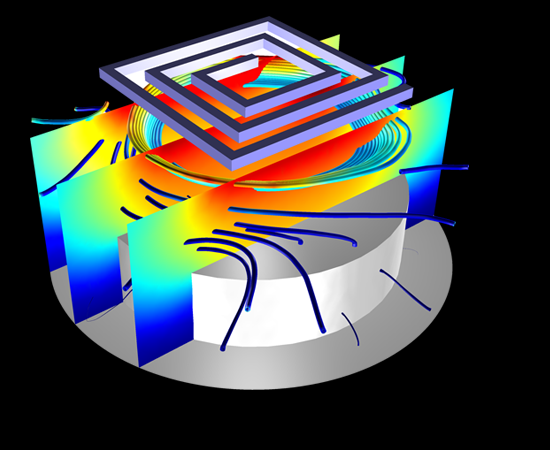
After the recent technological advancements, it would be logical to tell about one representative of passive radio elements - coils of inductance. But the story about them will have to start from afar, to recall the existence of a magnetic field, because it is the magnetic field that surrounds and permeates the coils, it is in the magnetic field, most often the variable coils, that they work. In short, this is their habitat.
Magnetism as a property of matter
Magnetism is one of the most important properties of matter, as well as, for example, mass or electric field. The phenomena of magnetism, however, as well as electricity, were known for a long time, only then science could not explain the essence of these phenomena. An incomprehensible phenomenon was called "magnetism" by the name of the city of Magnesia, which was once in Asia Minor. It was from the ore mined nearby that permanent magnets were obtained.

But permanent magnets in the framework of this article are not particularly interesting. Since it was promised to talk about coils of inductance, then it will most likely be about electromagnetism, it is by no means a secret that even around the wire with current there is a magnetic field.
In modern conditions, to investigate the phenomenon of magnetism at the initial, at least level, is easy enough. To do this, you need to collect a simple electrical circuit from the battery and a light bulb for a flashlight. As an indicator of the magnetic field, its direction and intensity, one can use the usual compass.
The magnetic field of direct current
As you know, the compass shows the direction to the North. If the wires of the simplest circuit mentioned above are placed nearby and the light is turned on, the compass needle will slightly deviate from its normal position.
By connecting in parallel another light bulb, you can double the current in the circuit, causing the rotation angle of the arrow to increase slightly. This indicates that the magnetic field of the wire with the current has become larger. It is on this principle that the arrow measuring devices work.
If the polarity of the battery is reversed, the compass needle will also turn by the other end - the direction of the magnetic field in the wires has also changed in direction. When the circuit is turned off, the compass needle will return to its legal position. There is no current in the coil, nor is there a magnetic field.
In all these experiments, the compass plays the role of a trial magnetic needle, just as the study of a constant electric field is performed by a test electric charge.
On the basis of such simple experiments, it can be concluded that magnetism appears due to an electric current: the stronger this current, the stronger the magnetic properties of the conductor. And where does the magnetic field from permanent magnets come from, because they were not connected to a battery with wires?
Fundamental scientific studies have shown that permanent magnetism is based on electrical phenomena: each electron is in its own electric field and has elementary magnetic properties. Only in most substances these properties are mutually neutralized, and for some reason they are added to one large magnet.
Of course, in fact, everything is not so simple and simple, but, in general, even permanent magnets have their miraculous properties due to the movement of electric charges.
And what kind of magnetic lines are they?
Magnetic lines can be seen visually. In the school experience in physics lessons, metal sawdust is poured onto a sheet of cardboard for this purpose, and a permanent magnet is placed below. Tapping lightly on the cardboard sheet can achieve the picture shown in Figure 1.
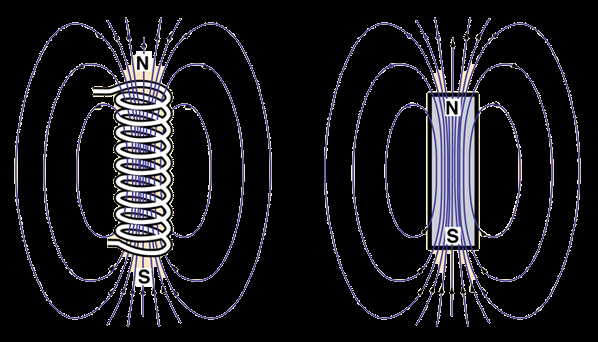
Figure 1.
It is not difficult to see that the magnetic lines of force exit from the north pole and enter the southern pole without tearing. Of course, we can say that it is on the contrary, from the south to the north, but it's so accepted, therefore, from the northern to the southern one. In the same way as once accepted the direction of the current from plus to minus.
If instead of a permanent magnet through a cardboard to pass a wire with a current, then metal sawdust will show it, a conductor, a magnetic field. This magnetic field has the form of concentric circular lines.
To study the magnetic field, you can do without sawdust. It is sufficient to move a trial magnetic needle around the conductor to see that the magnetic lines of force are indeed closed concentric circles. If we move the test arrow to the side where the magnetic field deflects it, we will definitely return to the same point where the movement started. Likewise, as walking around the Earth: if you go nowhere without turning, then sooner or later you will come to the same place.

Figure 2.
Rule drills
The direction of the magnetic field of the conductor with the current is determined by the rule of the drill, - a tool for drilling holes in the tree. Here everything is very simple: the drill must be rotated so that its translational motion coincides with the direction of current in the wire, then the direction of rotation of the handle will show where the magnetic field is directed.
 Figure 3.
Figure 3."The current comes from us" - the cross in the middle of the circle is the feather of the arrow flying behind the plane of the drawing, and where "The current is coming to us", the tip of the arrow flying from behind the plane of the leaf is shown. At least, this explanation of these designations was given at the physics lessons at school.
Interaction of magnetic fields of two conductors with a current
 Figure 4.
Figure 4.If we apply the drill rule to each conductor, then determining the direction of the magnetic field in each conductor, we can say with confidence that the conductors with the same current direction are attracted, and their magnetic fields are added together. Conductors with currents of different directions are mutually repelled, their magnetic field is compensated.
Inductor
If a conductor with a current is made in the form of a ring (coil), then it has its own magnetic poles, north and south. But the magnetic field of one revolution, as a rule, is small. Much better results can be achieved by winding the wire in the form of a coil. Such a part is called an inductor or simply inductance. In this case, the magnetic fields of the individual turns add up, mutually reinforcing each other.
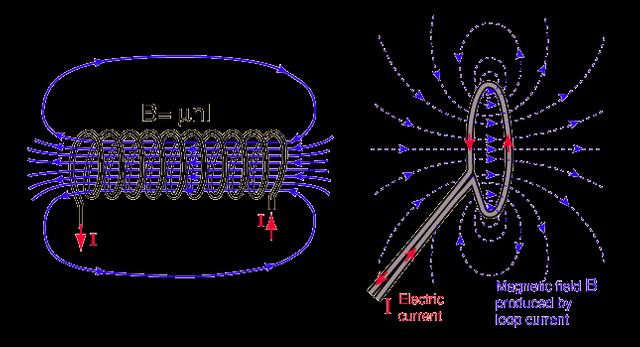
Figure 5.
Figure 5 shows how you can get the sum of the magnetic fields of the coil. It seems to be possible to supply each turn from its source, as shown in Fig. 5.2, but it is easier to connect the turns in series (simply wind one wire).
It is quite obvious that the greater the number of coil turns, the stronger its magnetic field. Also, the magnetic field depends on the current through the coil. Therefore, it is quite right to assess the ability of a coil to create a magnetic field by simply multiplying the current through the coil (A) by the number of turns (W). Such a value is called ampere-turns.
Coil with core
The magnetic field produced by the coil can be significantly increased if a core of ferromagnetic material is inserted into the coil. Figure 6 shows a table with the relative magnetic permeability of various substances.
For example, transformer steel will make the magnetic field about 7..7.5 thousand times stronger than in the absence of a core. In other words, inside the core the magnetic field will rotate the magnetic needle 7000 times more (this can only be imagined in my mind).
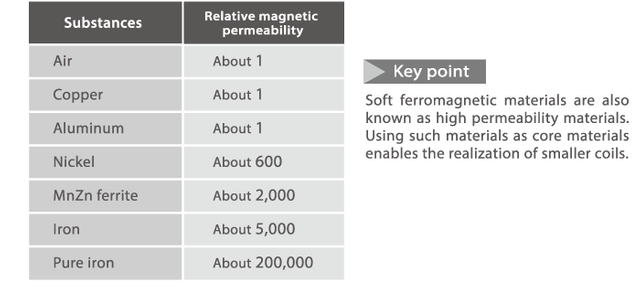
Figure 6.
At the top of the table are placed paramagnetic and diamagnetic substances. The relative permeability μ is indicated relative to the vacuum. Consequently, paramagnetic substances slightly strengthen the magnetic field, and diamagnetic slightly weaken. In general, these substances have no particular effect on the magnetic field. Although, at high frequencies, brass or aluminum cores are sometimes used to adjust the contours.
At the bottom of the table are placed ferromagnetic substances, which greatly enhance the magnetic field of the coil with current. So, for example, a core made of transformer steel will make the magnetic field stronger by exactly 7500 times.
How to measure the magnetic field
When units were needed to measure electrical quantities, the electron charge was taken as the standard. From the charge of the electron was formed a very real and even tangible unit - a pendant, and on its basis everything was simple: ampere, volt, ohm, joule, watt, farada.
And what can be taken as a starting point for measuring magnetic fields? Somehow tie to the magnetic field of the electron is very problematic. Therefore, as a unit of measurement in magnetism, a conductor is adopted, along which a constant current of 1 A flows.
Characteristics of the magnetic field
The main characteristic is tension (H). It shows the force with which the magnetic field acts on the test conductor mentioned above, if the case occurs in a vacuum. Vacuum is designed to exclude the influence of the environment, so this characteristic - the tension is considered absolutely clean. Ampere per meter (a / m) is taken as the unit of tension. Such a tension appears at a distance of 16 cm from the conductor, which is the current 1A.
The field strength only indicates the theoretical ability of the magnetic field. The real ability to act is reflected by another value of the magnetic induction (B). It shows the actual force with which the magnetic field acts on a conductor with current in 1A.
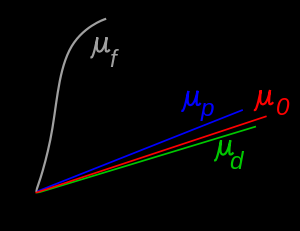
Figure 7.
If 1A current flows in a conductor 1A and it is expelled (attracted) with a force of 1Н (102Г), then say that the value of the magnetic induction at a given point is exactly 1 Tesla.
Magnetic induction is a vector quantity, besides the numerical value, it also has a direction that always coincides with the direction of the trial magnetic needle in the magnetic field under study.
Characteristics of the magnetic field
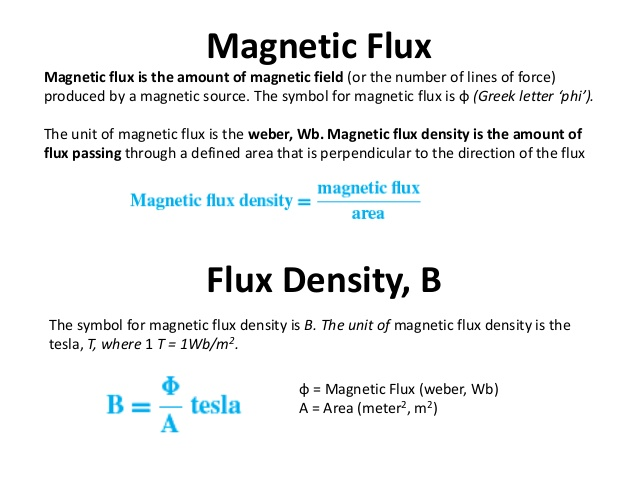
Figure 8
The unit of magnetic induction is Tesla (TL), although in practice the smaller Gauss unit is often used: 1T = 10,000G. Is this a lot or a little? The magnetic field near a powerful magnet can reach several Tesla, near the magnetic needle of a compass no more than 100 Gs, the Earth's magnetic field near the surface is about 0.01 Gs and even lower.
Magnetic flow
The magnetic induction vector B characterizes the magnetic field only at one point in space. To evaluate the effect of a magnetic field in a certain space, another concept is introduced, such as a magnetic flux (Φ).
In fact, it represents the number of lines of magnetic induction passing through a given space through an area: Φ = B * S * cosα. This picture can be represented in the form of rain drops: one line is one drop (B), and all together this is the magnetic flux Φ. This is how the magnetic lines of the individual coils of the coil are connected to the common stream.
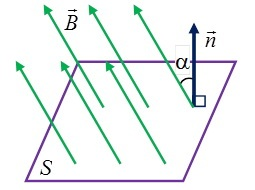
Figure 9.
In the SI system, Weber (Bb) is taken as the unit of the magnetic flux, such a flow occurs when the induction in 1 T acts on an area of 1 sq.m.
Magnetic circuit
The magnetic flux in various devices (motors, transformers, etc.), as a rule, passes through a certain path, called a magnetic circuit or simply a magnetic circuit. If the magnetic circuit is closed (the core of the ring transformer), then its resistance is small, the magnetic flux passes unhindered, concentrates inside the core. The figure below shows examples of coils with closed and open magnetic circuits.

Figure 10.
Resistance of a magnetic circuit
But the core can be cut and pulled out of it a piece, make a magnetic gap. This will increase the overall magnetic resistance of the circuit, therefore, reduce the magnetic flux, and in general, the induction will decrease throughout the core. This is the same as in the electrical circuit to sequentially seal a large resistance.
If the resulting gap is covered with a piece of steel, then it turns out that in parallel with the gap an additional section with a smaller magnetic resistance was connected, which will restore the disturbed magnetic flux. This is very similar to a shunt in electrical circuits. By the way, for a magnetic circuit there is also a law, which is called Ohm's law for a magnetic circuit.
The main part of the magnetic flux will pass through the magnetic shunt. It is this phenomenon that is used in the magnetic recording of audio or video signals: the ferromagnetic layer of the tape overlaps the gap in the core of the magnetic heads, and the entire magnetic flux is closed through the tape.
The direction of the magnetic flux created by the coil can be determined using the rule of the right hand: if four elongated fingers indicate the direction of the current in the coil, the thumb will show the direction of the magnetic lines, as shown in Figure 13.
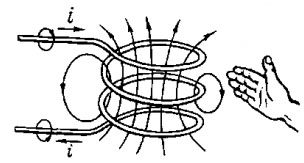
Figure 11.
It is generally accepted that magnetic lines emerge from the north pole and go into the south pole. Therefore, the thumb in this case indicates the location of the south pole. Check whether this is so, again with the help of the compass needle.
How the electric motor works
It is known that electricity can create light and heat, participate in electrochemical processes. After getting acquainted with the basics of magnetism, one can talk about how electric motors work.
Electric motors can be of very different design, power and operating principle: for example, DC and AC, stepper or collector. But for all the variety of designs, the principle of operation is based on the interaction of the magnetic fields of the rotor and the stator.
To obtain these magnetic fields, a current is passed through the windings. The greater the current, and the higher the magnetic induction of the external magnetic field, the more powerful the motor. To strengthen this field, magnetic cores are used, so there are so many steel parts in electric motors. In some DC motor models, permanent magnets are used.
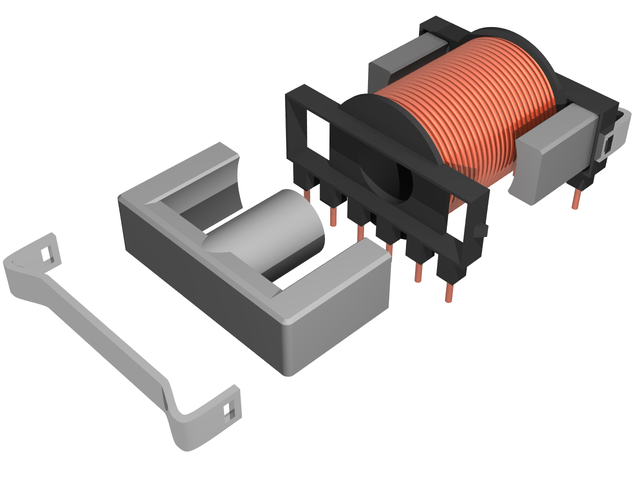
Figure 12.
Here, one can say, everything is clear and simple: a current passed through the wire, a magnetic field was obtained. Interaction with another magnetic field causes this conductor to move, and even perform mechanical work.
The direction of rotation can be determined by the rule of the left hand. If four elongated fingers show the direction of the current in the conductor, and the magnetic lines enter the palm, then the folded thumb will indicate the direction of pushing the conductor in the magnetic field.
References for Text and Images:
- http://www.play-hookey.com/dc_theory/inductors/components_inductors.html
- http://bucarotechelp.com/computers/architecture/82000702.asp
- https://www.autodesk.com/products/eagle/blog/inductor-plain-english/
- http://8051-microcontrollers.blogspot.in/2014/10/inductor-what-it-doeshow-it.html#.WnDYIrPhWM8
- https://www.nde-ed.org/EducationResources/CommunityCollege/EddyCurrents/Physics/selfinductance.htm
- http://philschatz.com/physics-book/contents/m42420.html
- https://www.wonderwhizkids.com/images/content/physics/Electromagnetism/EM_induction/Concept_map/Types_of_Induction.html
- http://info.ee.surrey.ac.uk/Workshop/advice/coils/force.html
Support @steemstem and the #steemstem
project - curating and supporting quality STEM
related content on Steemit

Being A SteemStem Member
Can you apply this to explain our magnetic human bodies...or how we have "magniticism" towards some but not others...does this apply to the vibe one recieves from other humans? Nice Blog.
No, none of that. The human body actually isn't very magnetic at all requiring very very strong detectors to even use it at all (ref biomagnetism) and being magnetic would not change with someones intentions.
Maybe Im confusing magnetism with vibration...
http://www.dailymail.co.uk/sciencetech/article-5334421/Earths-magnetic-poles-signs-FLIP.html
Pole Shift?
Happens every few thousand (like 10,000 or 100,000) years or so. Not super uncommon and we do not know exactly why but yeah its been hypothesized by many that we are going to have a magnetic pole shift in the next 1000 years or so. Will it actually happen, idk.
I see you have each of your images labeled (figure 1 through 12) but I was curious if you could state where the images came from directly. I truly enjoyed the post (like a lot) and yeah.
This post has received a 0.72% upvote from thanks to: @marverick984.
thanks to: @marverick984.
For more information, click here!!!!
Send minimum 0.100 SBD to bid for votes.
Do you know, you can also earn daily passive income simply by delegating your Steem Power to @minnowhelper by clicking following links: 10SP, 100SP, 500SP, 1000SP or Another amount. (10 SP minimum)
This post has received a 0.31 % upvote from @booster thanks to: @marverick984.
Greetings! I am a minnow exclusive bot that gives a 5X upvote!
I recommend this amazing guide on how to be a steemit rockstar!
I was made by @EarthNation to make Steemit easier and more rewarding for minnows.